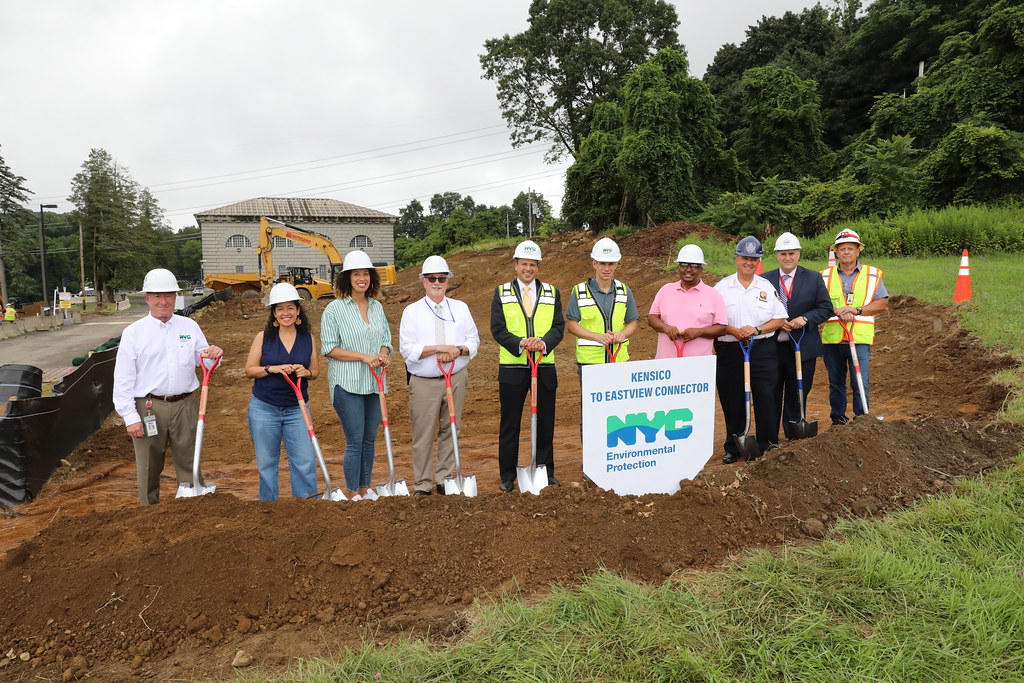New York City Department of Environmental Protection Breaks Ground on $1.9 Billion Water Tunnel in Westchester County
July 23, 2024
New tunnel will run approximately 500 feet below ground and improve flexibility between vital water-supply facilities that serve more than 9 million people in New York City and Westchester County;
Project is among more than $3 billion in DEP capital commitments throughout Westchester County alone that will improve nation’s largest municipal water supply system
The New York City Department of Environmental Protection (DEP) today broke ground on the $1.9 billion Kensico to Eastview tunneling and facilities upgrade project in the Westchester County town of Mt. Pleasant that will improve the operational flexibility of the drinking water supply for more than 9 million people in the City and throughout southern Westchester County. The project will be New York City’s largest water-supply tunneling effort in Westchester County since the 1940s, and its construction will create hundreds of jobs for local laborers.
The centerpiece of the project—known as the Kensico-Eastview Connection (KEC)—will be a 2-mile-long tunnel between Kensico Reservoir and the Catskill-Delaware Ultraviolet Light Disinfection Facility (CDUV) in Eastview. The new tunnel will provide an additional conveyance between these vital components of the water supply system, giving DEP the ability to take other facilities out of service for periodic maintenance and inspection.
“Creating additional redundancy in our vital water supply system is an essential investment for the long-term resilience of the remarkable feat of engineering that provides more than 9 million New Yorkers with a reliable supply of pristine tap water,” DEP Commissioner Rohit T. Aggarwala said. “This project will help us fulfill our commitment to providing consistent and reliable delivery of the highest-quality water to New York City and the growing population centers in Westchester County.”
The first phase of construction includes site preparation at the DEP campus adjacent to Kensico Reservoir, followed by the digging of two large shafts, 400-500 feet deep, the tunneling between the two shafts, and the addition of several new facilities and upgrades at the Kensico campus. All phases of the project are expected to span a ten-year period with the new tunnel coming fully online by 2035.
Kensico Reservoir is located north of White Plains and is a vital component of New York City’s Catskill-Delaware Water Supply System. The reservoir stores approximately 30 billion gallons of water at full capacity. DEP draws about 1 billion gallons of drinking water from Kensico Reservoir each day to meet the demand of 8.6 million residents in the five boroughs of New York City and approximately 500,000 residents of Westchester County whose communities are connected to the City’s system. As it moves towards the City, drinking water that leaves Kensico Reservoir is also treated at CDUV.
The KEC tunnel will stretch the approximately 2 miles from Kensico Reservoir to CDUV in Eastview, the largest such facility in the world. The finished tunnel will be 27 feet in diameter and run 400-500 feet below ground with a capacity to carry as much as 2.6 billion gallons of water each day. The design accounts for future growth in the City and Westchester County, the potential addition of treatment facilities, and the need to periodically take other infrastructure out of service for maintenance or inspection.
The project also includes new facilities and site work at both Kensico Reservoir and CDUV. A century-old intake chamber at Kensico Reservoir will be upgraded and enlarged to draw water into the new tunnel, the reservoir’s shoreline around that intake chamber will be improved to prevent sediment from escaping into the new tunnel, and the Kensico campus will receive utility, grading and drainage upgrades. In addition, a new screen chamber to remove debris from the water will be constructed just north of DEP’s main campus at the reservoir, near Columbus Avenue in Valhalla, and the chemical addition systems at Kensico Reservoir will be upgraded to ensure for the continued proper treatment of drinking water.
DEP will also build a connection chamber at CDUV in Eastview to receive water from the new tunnel. Work at this site will also include several projects related to drainage, stormwater and utility improvements.
Kensico Reservoir was built in 1915 as part of New York City’s Catskill Water Supply System. Kensico was later modified in the 1940s to also receive water from the City’s Delaware Water Supply System, also in the Catskills. Those two systems—collectively referred to as the Catskill-Delaware System—comprise the largest unfiltered water supply in the United States.
Also this year, DEP is expecting to break ground on more than $1 billion in facility and infrastructure additions and improvements at Hillview Reservoir in the City of Yonkers, which is the last stop for water from the Catskill reservoirs before it enters the water tunnels that feed the five boroughs.
The KEC Project is required by, and must be constructed in accordance with, the terms of the Hillview Consent Decree and Judgment entered by the United States District Court of the Eastern District of New York on May 15, 2019, and the Final Environmental Impact Statement pursuant to the State Environmental Quality Review Act is available online.
DEP manages New York City’s water supply, providing approximately 1 billion gallons of high-quality drinking water each day to nearly 10 million residents, including 8.5 million in New York City. The water is delivered from a watershed that extends more than 125 miles from the city, comprising 19 reservoirs and three controlled lakes. Approximately 7,000 miles of water mains, tunnels and aqueducts bring water to homes and businesses throughout the five boroughs, and 7,500 miles of sewer lines and 96 pump stations take wastewater to 14 in-city treatment plants. DEP also protects the health and safety of New Yorkers by enforcing the Air and Noise Codes and asbestos rules. DEP has a robust capital program, with a planned $29 billion in investments over the next 10 years. For more information, visit nyc.gov/dep, like us on Facebook, or follow us on X, formerly known as Twitter.





